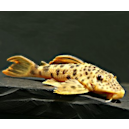Hello pleco fans,
a new issue of Aquaristik Fachmagazins was published. On a couple of articles I want to make you aware.
Erik Schiller “Corydoras sp. CW43 oder doch Corydoras eques” (“Corydoras sp. CW43 or Corydoras eques“)
Erik writes Corydoras sp. CW43 and Corydoras eques are indistinguishable. Already in one shipment, there are some animals which differ from the others of the same delivery more.
Next Erik reported that a fisherman in Iquitos (Peru) offered 120 such Corydoras, who had been caught in Brazil.
Erik believes that Corydoras sp. CW43 and Corydoras eques are the same species.
His Corydoras sp. CW43 spawned several times spontaneously at a temperature of 21 to 23°C. From other aquarists Corydoras eques were grown at temperatures of 25 to 27 °C. This prompted Erik his animals initially at 26 ° C to keep and then for 3 days to lower the temperature, leading to spawn.
Interesting is certainly also Erik’s observation that an additional flow of this Corydoras scared.
Thomas Friedrich Schäfer & Marcel Reiter “Aqua Diorama”
This is about underwater landscapes in the showcase. Mainly it comes naturally to the establishment of the aquarium. As aquarium inhabitants it was decided to Metynnis argenteus and Baryancistrus xanthellus. To prevent algae were later inserted Clithon corona and Cardina japonica. A little later, we could set Hemigrammus rodwayi to the aquarium.
Ingo Seidel “Zwei neue CW-Nummern wurden vergeben” (“Two new CW-numbers were assigned”)
It’s about CW098 and CW099 from Rio Negro, Brazil.
A Brazilian exporter has CW098 the company aquaglobal (Seefeld, Germany) offered as Corydoras bicolor. Ingo wrote that the species more similar to C. brevirostris from Guyana
CW099 is to be confusingly similar to Corydoras delphax from Colombia.
Daniel Konn-Vetterlein “Scleromystax sp. CW038″
Like other Scleromystax species CW038 comes from the south of Brazil.
Daniel had initially put the Scleromystax in an aquarium on the balcony.
There he observed that the Scleromystax in the evening visited the corner, in which the sun was shined longest. In the morning, the Scleromystax were then in the corner, in which the sun’s rays came first.
Also during the day sunny places in the aquarium were visited. Daniel watched similar from other species in the natural habitats.
Daniel Konn-Vetterlein “Ageneiosus marmoratus, der marmorierte Delfinwels” (“Ageneiosus marmoratus, the marbled dolphin catfish”)
Daniel wrote Ageneiosus marmoratus are not complicated as Ageneiosus atronasus, which was imported from Peru.
To feed the Ageneiosus need live food, or for emergency frozen food. They also need very much food.
Young marbled dolphin catfishes look very nice. But at the age they lose this beauty.
With 35 cm in length, the Ageneiosus marmoratus are only suitable for large aquariums.
Dr. Hans-Joachim Herrmann “Designerzuchtformen” (“Designer breed forms”)
The author looks at the origin of new varieties, for examples cattles and the cultivation of cereals (barley).
He describes the artistic streak that must have had so many scientists of bygone days, when he had to draw in his works, animals and plants, because there did not exist the photograph.
At about 25 pages it comes to breeding, designer breed, …
He called as examples of cultivated forms of catfishes:
Corydoras aeneus “Longfin”, Corydoras paleatus “Longfin”, Aspidoras sp. C125 “Red”, Corydoras sp. “Peru Goldstripe Albino”
More detailed information can be found in Aquaristik Fachmagazin.
Enjoy the read.

